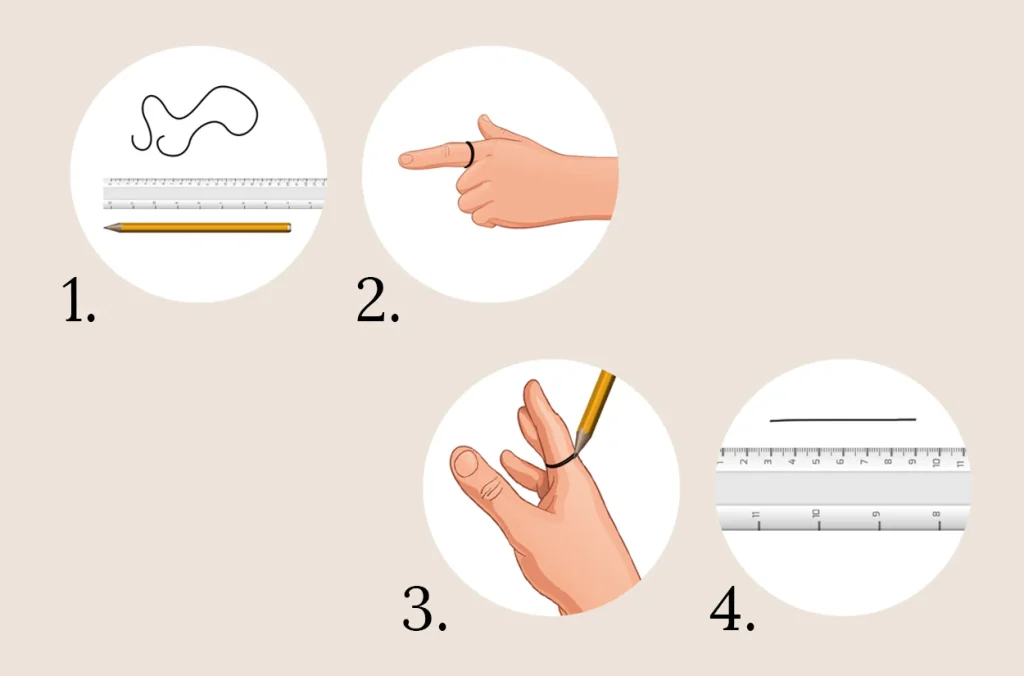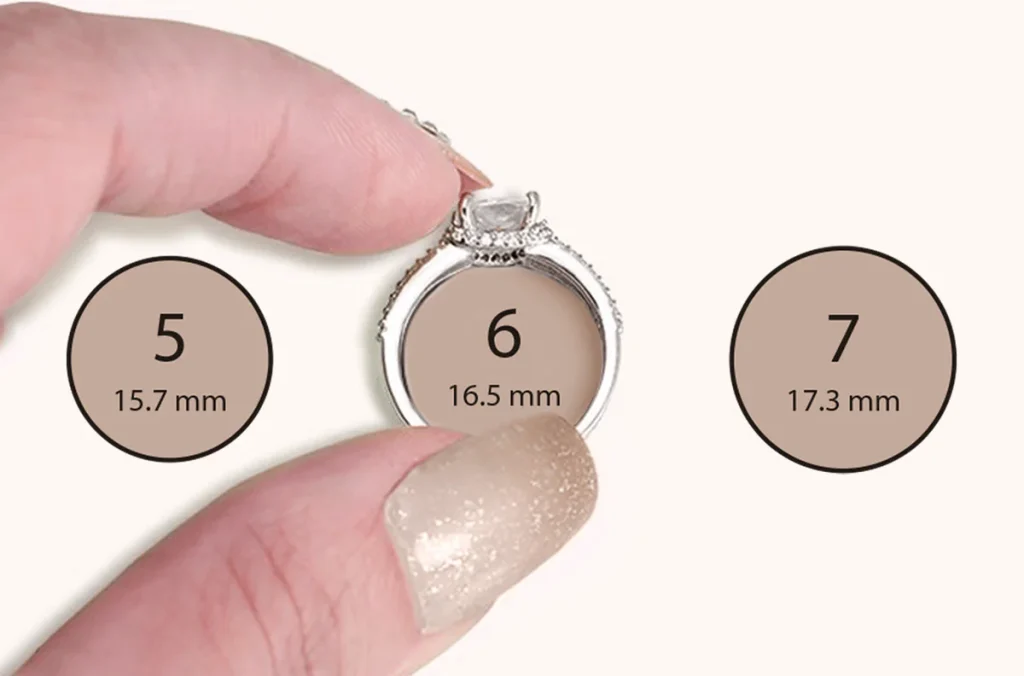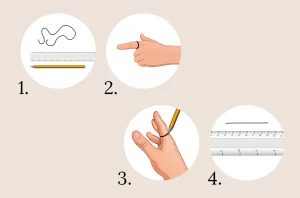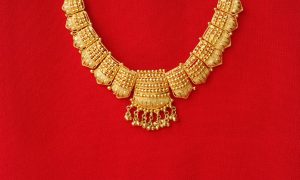Finding the perfect ring starts with knowing your exact ring size. Whether you’re shopping for an engagement ring, a wedding band, or simply treating yourself to a beautiful piece of jewelry, the right fit makes all the difference. Too loose, and you risk losing your precious ring. Too tight, and you’ll face discomfort every time you wear it. In this guide, I’ll walk you through several foolproof methods to measure your ring size accurately. No fancy tools are required—just your attention to detail and a few minutes of your time.
The Paper Method
The paper method is one of the simplest ways to measure your ring size without specialized tools. I’ve found this technique particularly useful for those unexpected moments when you need to know your size quickly.
To start, grab a small strip of paper about 4 inches long and a quarter-inch wide. Wrap it snugly around the base of your finger where you plan to wear the ring. The paper shouldn’t squeeze your finger, but it should make contact all the way around. Use a pen to mark where the paper overlaps, creating a complete circle.
Measure the length from the beginning of the paper to your mark using a ruler with millimeter measurements. This number represents the circumference of your finger. To convert this measurement to a standard ring size, you’ll need to divide the length by pi (approximately 3.14) to get the diameter and then compare it to a ring size chart.
Many people mess up this method by pulling the paper too tight or measuring when their fingers are swollen. Try taking measurements at different times of the day for consistency, as our finger size fluctuates based on temperature, activity level, and even what we’ve eaten.
The String Method

If you find the paper too flimsy for an accurate measurement, the string method offers a great alternative. This approach is my personal favorite for at-home sizing.
First, find a piece of non-stretchy string, dental floss, or even a thin strip cut from a plastic bag. Wrap it around your finger where the ring will sit, making sure it’s snug but not tight. Mark the point where the string overlaps, then lay it flat against a ruler to measure the length in millimeters.
Once you have your measurements, consult a ring size conversion chart to find your corresponding ring size. Most jewelry websites offer these charts, showing the relationship between millimeter measurements and standard ring sizes.
The string method works wonderfully because the material conforms nicely to your finger shape. Remember that your knuckle is typically wider than the base of your finger, so your ring needs to slide over it comfortably while still fitting securely at the base.
Measure an Existing Ring
Already own a ring that fits perfectly? This might be the most accurate method of all. Find a ring that fits the intended finger comfortably and measure its inside diameter.
Place the ring on a flat surface and use a ruler to measure straight across the inner circle from one side to the other. Be precise—even half a millimeter can make a difference in fit. Alternatively, you can trace the inner circle of the ring on paper and measure the diameter of your drawing.
This method is particularly helpful when purchasing a surprise engagement ring. You can secretly borrow a ring your partner already wears on the correct finger, measure it, and return it without raising suspicion about your romantic plans.
When using this technique, make sure you’re measuring a ring that’s similar in width to the one you plan to buy. Wider bands tend to fit more snugly, so you might need to go up a size compared to a narrower ring.
Using a Ring Sizer
For those who want professional-level accuracy without visiting a jewelry store, a ring sizer tool is worth the small investment. These inexpensive devices can be purchased online and deliver remarkably precise measurements.
Ring sizers come in various forms. Some are plastic or metal mandrels with size markings that you slip your finger into. Others are adjustable bands that you can tighten around your finger until you find the perfect fit. The most affordable option is a printable ring sizer that you can download from jewelry websites.
If you opt for a printable version, be extremely careful about scaling. Most browsers automatically adjust print sizes, which can throw off your measurements. Look for the “print at 100%” option in your print settings, and verify the sizing by measuring a reference line on the printed chart.
Ring Sizing Tips for a Perfect Fit
Getting an accurate ring size involves more than just wrapping something around your finger. Here are some insider tips I’ve learned after years in the jewelry business.
First, measure your finger at the end of the day when it’s likely to be at its largest. Our fingers tend to shrink in cold temperatures and swell in warm conditions or after physical activity. By measuring in the evening, you’ll avoid buying a ring that becomes uncomfortably tight later.
Second, don’t forget to consider your knuckle size. If you have large knuckles, you might need to order a slightly bigger ring and add sizing beads inside the band. These small adjustments allow the ring to slide over your knuckle but stay secure at the base of your finger.
Third, consider the width of the band. Wider bands typically require going up a half-size compared to narrower styles. This is because wider bands cover more finger surfaces and fit more snugly as a result.
Finally, remember that your dominant hand is usually slightly larger than your non-dominant hand. If you’re right-handed and planning to wear a ring on your right hand, you might need a larger size than for the same finger on your left hand.
How to Prepare for a Ring Sizing
Proper preparation can make a significant difference in getting an accurate ring size. I always tell my clients to avoid measuring when their hands are either very cold or very hot, as these conditions temporarily change finger size.
Before measuring, wash and dry your hands thoroughly. Lotions or oils can make your fingers slippery, affecting how measuring tools fit. It’s also best to avoid measuring after exercise or eating very salty foods, both of which can cause temporary swelling.
Suppose you’re purchasing a ring for a special occasion like a wedding that will take place in a different season; factor that into your sizing. Fingers tend to be smaller in winter months and larger during summer heat. A professional jeweler can help you account for these seasonal changes.
For those with enlarged knuckles due to arthritis or other conditions, consider rings with special designs, like those with tapered shanks or hinged openings that make them easier to put on and take off.
What’s the Average Ring Size for a Woman?
The average ring size for women in the United States falls between 5 and 7, with size 6 being the most common. However, these averages don’t tell the full story about what size might be right for you.
Height, weight, and bone structure all influence finger size. Taller women or those with larger frames typically wear larger ring sizes, while petite women often need smaller sizes. Even finger length plays a role—longer fingers tend to be slimmer relative to their length.
I’ve found that many women assume they’re a standard size 7 without measuring, only to discover they’re actually a 5.5 or a 8. That’s why personal measurement is so important, regardless of averages.
What’s the Average Ring Size for a Man?
For men, ring sizes run from an 8 to a 10, with the average being a 9. These are general guidelines for women and men, not rules.
Body type contributes significantly in deciding the ring size of a man. Larger hands are likely to have a taller or broader body build, which requires larger ring sizes. Men with muscular hands may need larger sizes even if they are not tall.
Age is also a factor in men’s ring size. Most men experience small increases in finger size over time, particularly in their 40s and beyond. When purchasing a forever piece like a wedding band, some jewelers recommend going up a bit to accommodate these potential changes.
Can My Phone Measure My Ring Size?
Technology has brought ring sizing into the digital age with smartphone apps that claim to measure your ring size using your phone’s camera. While these apps can be convenient, I recommend using them as preliminary tools rather than definitive methods.
Most ring-sizing apps work by asking you to place a credit card or other standard-sized object on a flat surface for reference. Then, you position your finger next to it and take a photo. The app uses the known dimensions of the reference object to calculate your finger size.
The results from these apps can vary significantly based on lighting conditions, camera angles, and how you position your finger. They’re useful for getting a ballpark figure, but I always suggest following up with one of the physical measuring methods discussed earlier for confirmation.
If you’re serious about accuracy, consider using a combination of methods—perhaps an app measurement followed by the string technique—to verify your size before making a purchase.
How Big is a Size-7 Ring?

A size 7 ring has an internal diameter of approximately 17.3 millimeters (0.68 inches) and a circumference of about 54.4 millimeters (2.14 inches). This is one of the most commonly purchased women’s ring sizes in the United States.
To visualize a size 7, it’s roughly the same diameter as a U.S. quarter. If you place a quarter against your finger and it appears to match the width comfortably, you might be close to a size 7.
When comparing ring sizes, each full size represents about a 0.8mm difference in diameter. For example, a size 6 ring has an internal diameter of about 16.5mm, while a size 8 measures around 18.1mm. These small increments make a significant difference in comfort, which is why precise measurement matters so much.
Conclusion
Finding your perfect ring size doesn’t have to be complicated. Whether you use paper, string, an existing ring, or a specialized tool, the key is to measure multiple times and consider factors like time of day, temperature, and bandwidth.
Remember that your ring should slide over your knuckle with slight resistance and then fit snugly—but comfortably—at the base of your finger. It shouldn’t spin freely or leave red marks when removed.
For especially important rings like engagement rings or wedding bands, consider having a professional jeweler confirm your size. Most jewelry stores offer free sizing services, even if you didn’t purchase your ring from them.
At the end of the day, the perfect ring isn’t just about beauty or symbolism—it’s also about comfort. A well-fitted ring can be worn daily for years without a second thought, becoming almost a part of you. Isn’t that exactly what we want from our most treasured jewelry?
ALSO READ: How to Find Sunglasses That Fit Your Face Shape
FAQs
Measure when your hands are at normal temperature, typically in the afternoon. Cold hands measure smaller than their true size.
Yes, your dominant hand is usually slightly larger, often by a half-size or full-size.
Fingers can fluctuate by up to half a size from morning to evening due to fluid retention and temperature changes.
Generally, size up for wider bands and rings with stones, and consider your knuckle size—if it’s large relative to your finger base, size up.
Remeasure every few years or after significant weight changes, pregnancy, or medical conditions affecting your hands.



